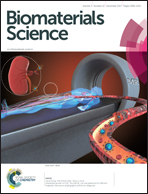Sequential growth of CaF2:Yb,Er@CaF2:Gd nanoparticles for efficient magnetic resonance angiography and tumor diagnosis†
Abstract
It is a significant challenge to develop nanoscale magnetic resonance imaging (MRI) contrast agents with high performance of relaxation. In this work, Gd3+-doped CaF2-based core–shell nanoparticles (CaF2:Yb,Er@CaF2:Gd) of sub-10 nm size were controllably synthesized by a facile sequential growth method. The as-prepared hydrophilic CaF2:Yb,Er@CaF2:Gd nanoparticles modified using PEG-PAA di-block copolymer benefited from the presence of Gd only in the outer CaF2 layer of the nanoparticles, which exhibited r1 as high as 21.86 mM−1 s−1 under 3.0 T, seven times as high as that of commercially used gadopentetate dimeglumine (Gd-DTPA). Low cytotoxicity, no hemolysis phenomenon and no potential gadolinium ion leakage phenomenon of the hydrophilic CaF2:Yb,Er@CaF2:Gd nanoparticles have been observed and confirmed. Clear vascular details can be observed in magnetic resonance angiography and obvious MR signal of 4T1 tumor area could be significantly improved by intravenous injection of the hydrophilic CaF2:Yb,Er@CaF2:Gd nanoparticles at a low dosage in mice. A series of in vivo biological safety evaluations confirmed the good biocompatibility of the hydrophilic CaF2:Yb,Er@CaF2:Gd nanoparticles, which might be employed in clinical blood pool imaging and tumor diagnosis as a safe and efficient MRI probe.



 Please wait while we load your content...
Please wait while we load your content...